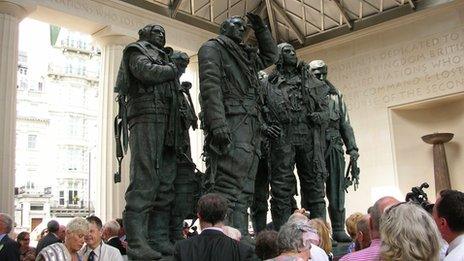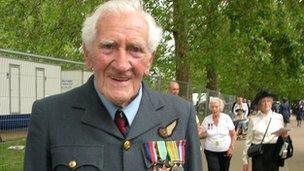Bomber Command Memorial moves veterans
- Published

The veterans crowded around the memorial after the dedication to have their pictures taken
Hundreds of RAF Bomber Command veterans have been getting a first look at the new memorial in London's Green Park honouring the sacrifice of 55,573 of their comrades during World War II.
Family members and relatives of some of those who died in 1939-1945 conflict also turned out to see the Queen dedicate architect Liam O'Connor's pavilion.
Many of the veterans, who are in their late 80s and 90s, were of the view that the publicly-funded £6m memorial was long overdue but now that it is finally standing were appreciative of its build and scale.
After the service, the veterans, wearing service medals, crowded around the memorial and had pictures taken with family members.
One marvelled at the detail in Philip Jackson's 9ft high bronze sculptures of seven Lancaster bomber airman after a mission, saying he had "not missed a thing".

Russell Oldmeadow was among the Commonwealth aircrew at the service
"The memorial is absolutely magnificent," added Russell Oldmeadow, 90, from Canberra, Australia, one of a number of Commonwealth airmen in Bomber Command who were present at the dedication.
"My brother was killed - that's one reason why I'm here," the Lancaster pilot said.
"But it's also a great occasion and I'm privileged."
About 5,000 of the 6,000 people at the dedication watched the service on a big screen in a "salute area", a short walk away.
There was applause as the Queen unveiled the sculptures and people described their first glimpse of the memorial as "impressive" and "moving".
The salute area event featuring music and entertainment was hosted by TV's Carol Vorderman and organised by the RAF Benevolent Fund, which will look after maintenance of the memorial and is seeking to raise £1.5m to help cover costs.
Amanda Brierley, 42, from Barnoldswick, Lancashire, came to honour the memory of her grandfather Arthur Davies, a rear gunner who died 15 years ago.
'Political issue'
Accompanied by her grandmother, Ms Brierley said: "We're here because he would have been here. He did think a memorial was missing."
It was a sentiment expressed by many at the event, who felt criticism of large-scale area bombing by the RAF near the end of WWII stalled plans for a memorial as it had become a "political issue".

Mr Parissien wore his old RAF jacket to the event
Pilot Eric Jones, 89, from Poole, said: "It's very definitely too late - so many would have loved to be here. I'm the last surviving member of my crew."
Harry Pugh, 88, from County Durham, a bomb aimer, said: "It right it's been done now but it's a great pity it has been delayed.
"I would have preferred it much more if it had been done in the past rather than as ancient history."
Reginald Parissien, 88, a radar operator who flew 18 missions before he was shot down over Dusseldorf in April 1944 and taken prisoner of war, was more philosophical.
Dressed in his old RAF uniform jacket, Mr Parissien, from Slough, shrugged his shoulders as he said "It's long overdue but has arrived now".
Military historian Bruce Blanche, from Dunblane, came to "pay tribute" to his uncle, flying officer Jimmy Lyon of the Royal Australian Air Force, who died in a training exercise after completing 30 missions from RAF Bardney in Lincolnshire.
There were no campaign medals specifically for Bomber Command after the war and Mr Blanche is hoping the memorial may be the "first gesture" towards such recognition.
"I've been overwhelmed by the veterans here who have shown a wonderful bravery, even now," he said.
"They are thrilled to be here. There's a buzz among them that at last Bomber Command is being honoured."
- Published28 June 2012
- Published27 June 2012
- Published21 May 2012